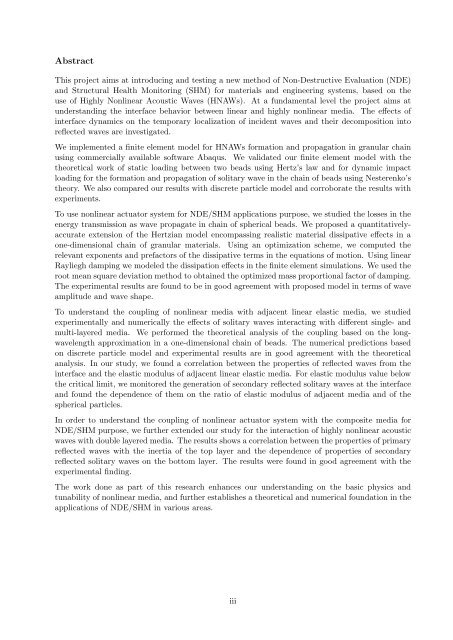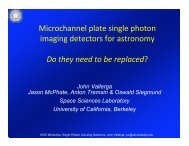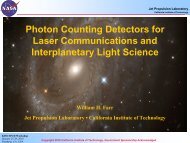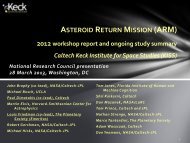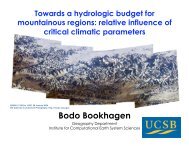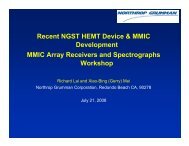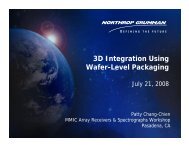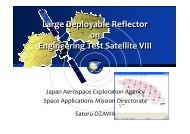Final Report - Keck Institute for Space Studies - Caltech
Final Report - Keck Institute for Space Studies - Caltech
Final Report - Keck Institute for Space Studies - Caltech
- No tags were found...
You also want an ePaper? Increase the reach of your titles
YUMPU automatically turns print PDFs into web optimized ePapers that Google loves.
AbstractThis project aims at introducing and testing a new method of Non-Destructive Evaluation (NDE)and Structural Health Monitoring (SHM) <strong>for</strong> materials and engineering systems, based on theuse of Highly Nonlinear Acoustic Waves (HNAWs). At a fundamental level the project aims atunderstanding the interface behavior between linear and highly nonlinear media. The effects ofinterface dynamics on the temporary localization of incident waves and their decomposition intoreflected waves are investigated.We implemented a finite element model <strong>for</strong> HNAWs <strong>for</strong>mation and propagation in granular chainusing commercially available software Abaqus. We validated our finite element model with thetheoretical work of static loading between two beads using Hertz’s law and <strong>for</strong> dynamic impactloading <strong>for</strong> the <strong>for</strong>mation and propagation of solitary wave in the chain of beads using Nesterenko’stheory. We also compared our results with discrete particle model and corroborate the results withexperiments.To use nonlinear actuator system <strong>for</strong> NDE/SHM applications purpose, we studied the losses in theenergy transmission as wave propagate in chain of spherical beads. We proposed a quantitativelyaccurateextension of the Hertzian model encompassing realistic material dissipative effects in aone-dimensional chain of granular materials. Using an optimization scheme, we computed therelevant exponents and prefactors of the dissipative terms in the equations of motion. Using linearRayliegh damping we modeled the dissipation effects in the finite element simulations. We used theroot mean square deviation method to obtained the optimized mass proportional factor of damping.The experimental results are found to be in good agreement with proposed model in terms of waveamplitude and wave shape.To understand the coupling of nonlinear media with adjacent linear elastic media, we studiedexperimentally and numerically the effects of solitary waves interacting with different single- andmulti-layered media. We per<strong>for</strong>med the theoretical analysis of the coupling based on the longwavelengthapproximation in a one-dimensional chain of beads. The numerical predictions basedon discrete particle model and experimental results are in good agreement with the theoreticalanalysis. In our study, we found a correlation between the properties of reflected waves from theinterface and the elastic modulus of adjacent linear elastic media. For elastic modulus value belowthe critical limit, we monitored the generation of secondary reflected solitary waves at the interfaceand found the dependence of them on the ratio of elastic modulus of adjacent media and of thespherical particles.In order to understand the coupling of nonlinear actuator system with the composite media <strong>for</strong>NDE/SHM purpose, we further extended our study <strong>for</strong> the interaction of highly nonlinear acousticwaves with double layered media. The results shows a correlation between the properties of primaryreflected waves with the inertia of the top layer and the dependence of properties of secondaryreflected solitary waves on the bottom layer. The results were found in good agreement with theexperimental finding.The work done as part of this research enhances our understanding on the basic physics andtunability of nonlinear media, and further establishes a theoretical and numerical foundation in theapplications of NDE/SHM in various areas.iii


